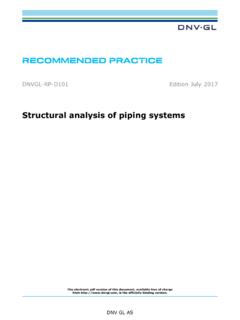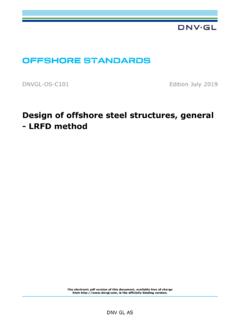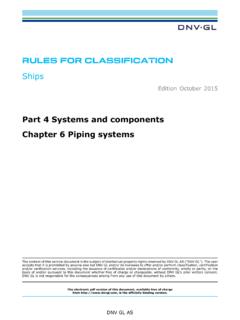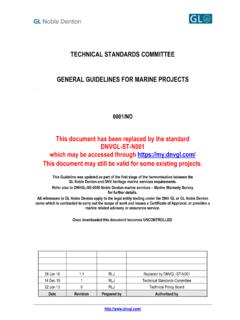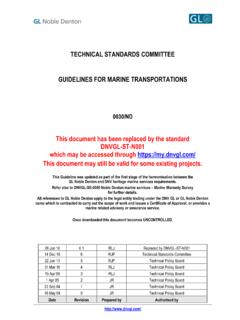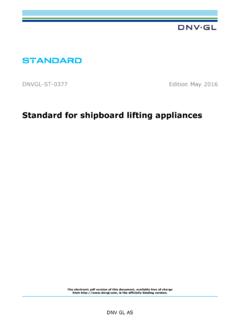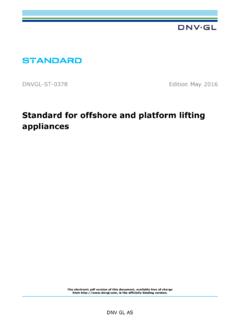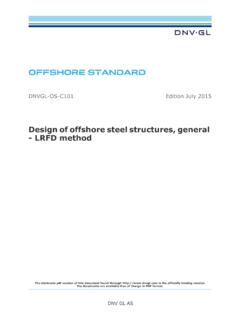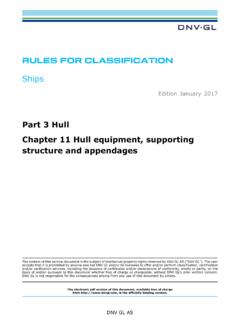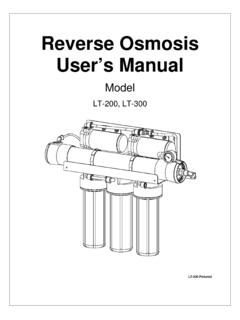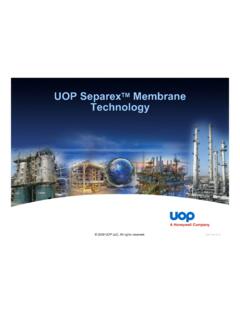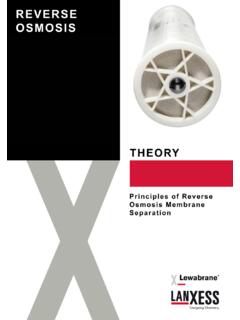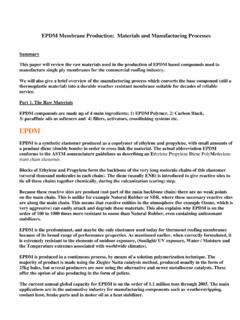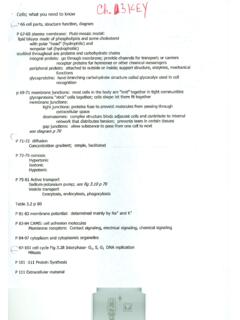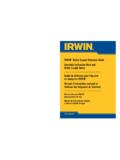Transcription of DNVGL-CG-0127 Finite element analysis
1 The electronic pdf version of this document, available free of chargefrom , is the officially binding GL ASCLASS GUIDELINEDNVGL-CG-0127 Edition October 2015 Finite element analysisFOREWORDDNV GL class guidelines contain methods, technical requirements, principles and acceptancecriteria related to classed objects as referred to from the rules. DNV GL ASAny comments may be sent by e-mail to any person suffers loss or damage which is proved to have been caused by any negligent act or omission of DNV GL, then DNV GL shallpay compensation to such person for his proved direct loss or damage.
2 However, the compensation shall not exceed an amount equal to tentimes the fee charged for the service in question, provided that the maximum compensation shall never exceed USD 2 this provision "DNV GL" shall mean DNV GL AS, its direct and indirect owners as well as all its affiliates, subsidiaries, directors, officers,employees, agents and any other acting on behalf of DNV - currentClass guideline DNVGL-CG-0127 . Edition October 2015 Page 3 Finite element analysisDNV GL ASCHANGES CURRENTThis is a new guideline DNVGL-CG-0127 . Edition October 2015 Page 4 Finite element analysisDNV GL ASCONTENTSC hanges 1 Finite element Objective of Class Calculation Material Global coordinate Corrosion Finite element Singularities in membrane Model 102 11 Section 2 Global strength 121 Objective and 122 Global structural FE Model Mesh Model Boundary 203 Load application for global FE analysis Yield strength Buckling strength Fatigue strength 3 Partial ship structural 241 Objective and guideline DNVGL-CG-0127 .
3 Edition October 2015 Page 5 Finite element analysisDNV GL Procedure of cargo hold Scantlings Structural Extent of Structural 303 Boundary Boundary conditions in cargo hold FE load combinations and load Sign Design rule Rule FE load Principles of FE load Load Internal and external Pressure application on FE External Internal Other 456 Hull girder Hull girder Procedure to adjust hull girder shear forces and bending Procedure to adjust hull girder torsional Summary of hull girder load analysis Yield strength Buckling strength 4 Local structure strength Objective and Modelling of standard structural Structural Fine mesh FE model for fatigue strength guideline DNVGL-CG-0127 .
4 Edition October 2015 Page 6 Finite element analysisDNV GL AS3 Selection of structural detail for fine mesh Screening based on fine mesh Loads and boundary Boundary 755 analysis Reference Permissible Acceptance criteria - fine mesh permissible yield utilisation 5 Beam Model Model Beam 83 Section 1 Class guideline DNVGL-CG-0127 . Edition October 2015 Page 7 Finite element analysisDNV GL ASSECTION 1 Finite element ANALYSIS1 GeneralThis Class Guideline describes the scope and methods required for structural analysis of ships and thebackground for how such analyses should be carried out.
5 The Class Guidelines application is based onrelevant Rules for Classification of DNV GL Rules for Classification of Ships may require direct structural strength analyses as given in analyses carried out in accordance with the procedure outlined in this Class Guideline will normallybe accepted as basis for plan the text refers to the Rules for Classification of Ships, the references refer to the latest edition of theRules for Classification of case of ambiguity between the rules and the Class Guideline, the rules shall be recognised Finite element software may be utilised provided that all specifications on mesh size, elementtype, boundary conditions etc.
6 Can be achieved with this computer wave loads are calculated from a hydrodynamic analysis , it is required to use recognised software. Asrecognised software is considered all wave load programs that can show results to the satisfaction of DNV Objective of Class GuidelineThe objective of this Class Guideline is: To give a guidance for Finite element analyses and assessment of ship hull structures in accordance withthe Rules for Classification of Ships. To give a general description of relevant Finite element analyses. To achieve a reliable design by adopting rational analysis Calculation methodsThe Class Guideline provides descriptions for three levels of Finite element analyses.
7 A) Global direct strength analysis to assess the overall hull girder response, given in ) Partial ship structural analysis to assess the strength of hull girder structural members, primarysupporting structural members and bulkheads, given in ) Local structure analysis to assess detailed stress levels in local structural details, given in Class Guideline, DNVGL-CG-0129 Fatigue assessment of ship structures, describes methods of local finiteelement analyses for fatigue provides descriptions for a 2 and 3 dimension beam analyses of ship Material propertiesStandard material properties are given in Table 1 Class guideline DNVGL-CG-0127 .
8 Edition October 2015 Page 8 Finite element analysisDNV GL ASTable 1 Material propertiesYoung s Modulus[kN/m2]Poisson ValueShear Modulus[kN/m2]Density[t/m3] minimum yield stress ReH has to be related to the material defined as indicated in the rules, RU Table 1. Consequently, it is recommended that every steel grade is represented by a separatematerial data set in the model, as the materials are defined in the structural Global coordinate systemThe following co-ordinate system is recommended; right hand co-ordinate system, with the x-axis positiveforward, y-axis positive to port and z-axis positive vertically from baseline to deck.
9 The origin should belocated at the intersection between aft perpendicular (AP), baseline and centreline. The co-ordinate system isillustrated in Figure should be noted that loads according to the rules, RU SHIP refer to a coordinate system with adifferent x-origin (located at aft end (AE) of the rule length L). This coordinate system is defined in the rules,RU SHIP [ ]. Figure 1 Global coordinate Corrosion DeductionFE models are to be based on the scantlings with the corrosion deductions according to the rules, RU Table 1, as follows 50% corrosion deduction for ships with class notation ESP; 0% corrosion deduction for other capacity assessment based on FE analysis is to be carried out with 100% corrosion 1 Class guideline DNVGL-CG-0127 .
10 Edition October 2015 Page 9 Finite element analysisDNV GL Finite element typesAll calculation methods described in this Class Guideline are based on linear Finite element analysis of threedimensional structural models. The general types of Finite elements to be used in the Finite element analysisare given in Table 2 Types of Finite elementType of Finite elementDescriptionRod (or truss) elementLine element with axial stiffness only and constant cross sectional area along thelength of the elementLine element with axial, torsional and bi-directional shear and bending stiffnessand with constant properties along the length of the (or plate) elementSurface element with in-plane stiffness and out-of-plane bending stiffness withconstant (or plane-stress)
